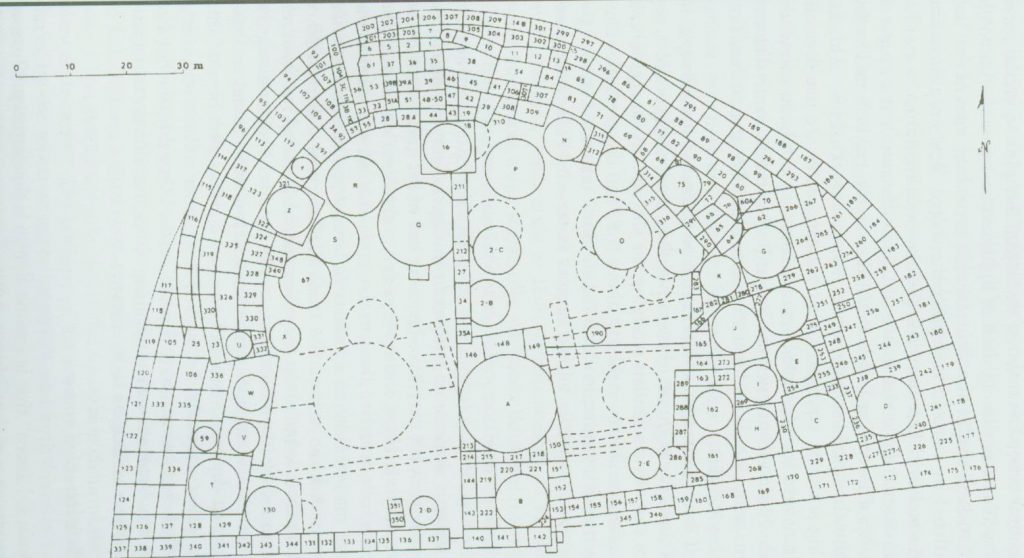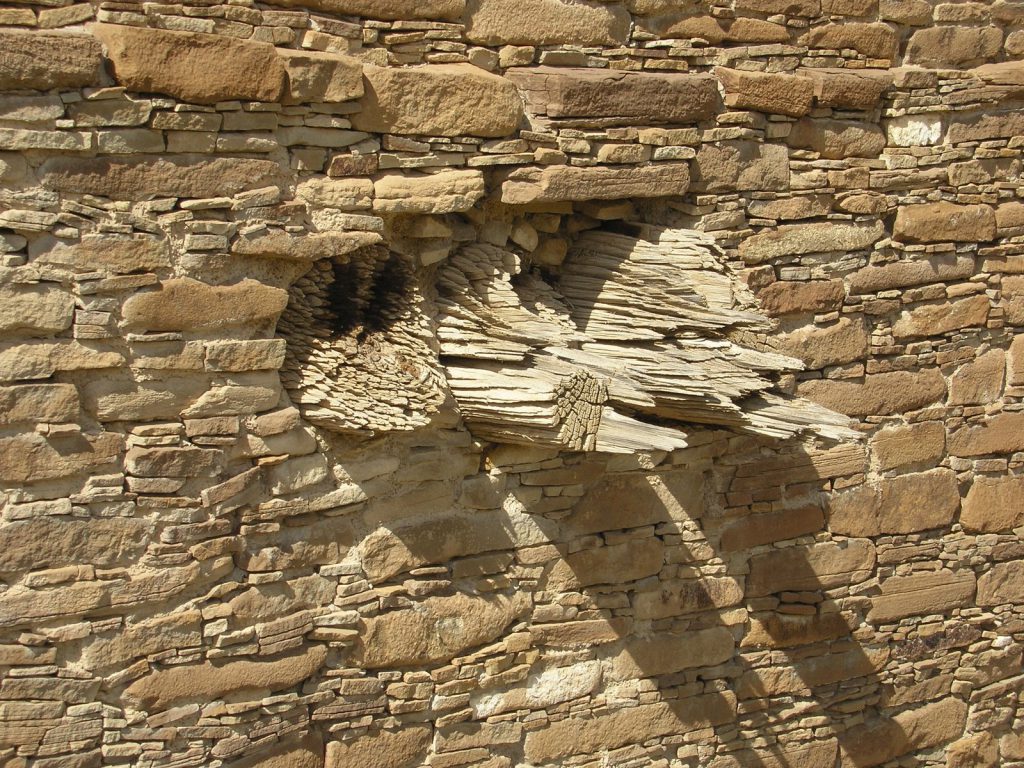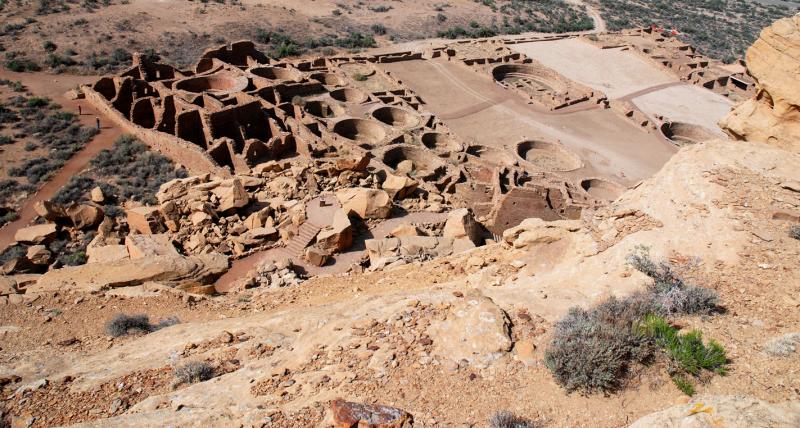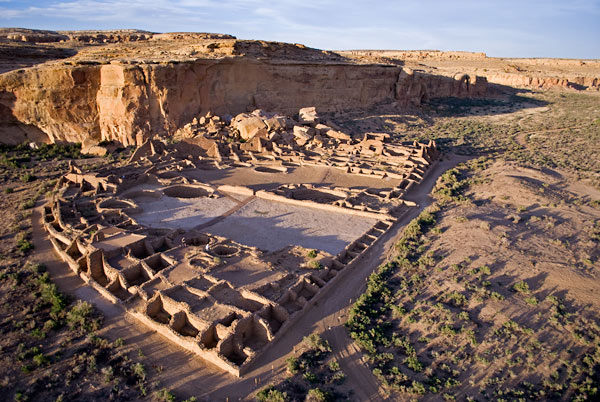Pueblo Bonito (Spanish for beautiful town), the largest and best-known great house in Chaco Culture National Historical Park, northern New Mexico, was built by the Ancestral Puebloans, who occupied the structure between AD 828 and 1126.
Pueblo Bonito is divided into two sections by a precisely aligned wall, which runs north to south through the central plaza. A Great Kiva is situated on either side of the wall, creating a symmetrical pattern common to many of the Great Houses. In addition to the Great Kivas, over thirty other kivas or ceremonial structures have been found, many also associated with the large central courtyard. Interior living spaces were quite large by the standards of the Ancient Pueblo.
The site covers 3 acres (1.2 ha) and incorporates approximately 800 rooms. In parts of the village, the tiered structure was four and five stories high. During later construction, some lower level rooms were filled with debris to better support the weight of the upper levels. The builder’s use of core-and-veneer architecture and multi-story construction produced massive masonry walls as much as 3 feet (0.91 m) thick.
Population estimates for the village vary. During the early 20th century, the structures were viewed as small cities, with people residing in every room. From this perspective, Pueblo Bonito could have accommodated several thousand inhabitants at its peak. Recent analysis has lowered the estimated population to less than 800, primarily due to the small number of usable hearths in the ruins. An analysis based on architecture estimated the resident population at 12 households, or about 70 people at its peak. These tend to be located on the ground floor, near the central plaza, and are associated with entrances to a series of rooms going deeper into the structure. Rooms were connected by a series of interior doorways, some of them in a T-shape. A family may have inhabited 3 to 4 rooms, with many small interior spaces being used for storage. There was generally no outside access to the room blocks other than from the central courtyard.
The site indicates the Puebloans comprehension of solar and lunar cycles; both of which are marked in the petroglyphs of the surrounding cliff area as well as in the architecture of Pueblo Bonito itself.It is possible that Pueblo Bonito is actually neither a village nor city. While its size has the capacity for a significant population, the environment may not have been ideal for sustaining a large population. Excavations at the site have not revealed significant trash middens indicating residential areas. A common suggestion is that Pueblo Bonito was a ritual center. This is not only evident in the existence of the kivas (which are more often than not attributed to ritual function) but also in the construction of the site and its relation to other Chaco Canyon sites. Although there were many occupants, only 50-60 burials were found here.
Pueblo Bonito, la casa mayor y más conocida en el Parque Histórico Nacional de la Cultura Chaco, al norte de Nuevo México, fue construida por los indigenas Puebloans, quienes ocuparon la estructura entre el 828 y el 1126 dC.
Pueblo Bonito está dividido en dos secciones por un muro alineado de manera precisa, que corre de norte a sur a través de la plaza central. Un Gran Kiva está situado a ambos lados de la pared, creando un patrón simétrico común a muchas de las Grandes Casas. Además de los Grandes Kivas, se han encontrado más de treinta kivas o estructuras ceremoniales, muchas de ellas asociadas con el gran patio central. Los espacios de vida interiores eran bastante grandes para los estándares del Pueblo Antiguo.
El sitio cubre 3 acres (1.2 ha) e incorpora aproximadamente 800 habitaciones. En partes del pueblo, la estructura escalonada tenía cuatro y cinco pisos de altura. Durante la construcción posterior, algunas habitaciones de niveles inferiores se llenaron con escombros para soportar mejor el peso de los niveles superiores.
Las estimaciones de población para el pueblo varían. A principios del siglo XX, las estructuras se consideraban ciudades pequeñas, con personas que residían en cada habitación. Desde esta perspectiva, Pueblo Bonito podría haber acomodado a varios miles de habitantes en su apogeo. Un análisis reciente ha reducido la población estimada a menos de 800, principalmente debido al pequeño número de hogares utilizables en las ruinas. Un análisis basado en la arquitectura estimó la población residente en 12 hogares, o alrededor de 70 personas en su punto máximo. Estos tienden a estar ubicados en la planta baja, cerca de la plaza central, y se asocian con entradas a una serie de habitaciones que se adentran en la estructura. Las habitaciones estaban conectadas por una serie de puertas interiores, algunas de ellas en forma de “T”. Una familia puede haber habitado de 3 a 4 habitaciones, con muchos espacios interiores pequeños que se utilizan para el almacenamiento. En general, no había acceso exterior a los bloques de habitaciones, excepto desde el patio central.
El sitio indica la comprensión de los puebloanos de los ciclos solares y lunares; ambos están marcados en los petroglifos del área del acantilado circundante, así como en la arquitectura de Pueblo Bonito. Es posible que Pueblo Bonito no sea en realidad un pueblo ni una ciudad. Si bien su tamaño tiene la capacidad para una población significativa, el ambiente puede no haber sido ideal para sostener una gran población. Las excavaciones en el sitio no han revelado una cantidad significativa de basureros que indiquen áreas residenciales. Una sugerencia común es que Pueblo Bonito era un centro ritual. Esto no solo es evidente en la existencia de los kivas (que a menudo se atribuyen a la función ritual) sino también en la construcción del sitio y su relación con otros sitios del Cañón del Chaco. Aunque había muchos ocupantes, solo se encontraban entre 50 y 60 enterramientos.







 |
| Evolution of Pueblo Bonito – Illustration by Stephen H. Lekson |
 |
| Image by Liba Kopeckova |
 |
| Image by QT Luong |
 |
| Image by Select Stone |
 |
| Casa Rinconada |
 |
| Image by Liba Kopeckova |
 |
| Image by Bob Metzler |
 |
| Image by Liba Kopeckova |
 |
| Image by Liba Kopeckova |
 |
| Image by Liba Kopeckova |
Further information on:
Chaco Archive – Pueblo Bonito
Tectónica blog
<http://hiddenarchitecture.blogspot.com.es>




























